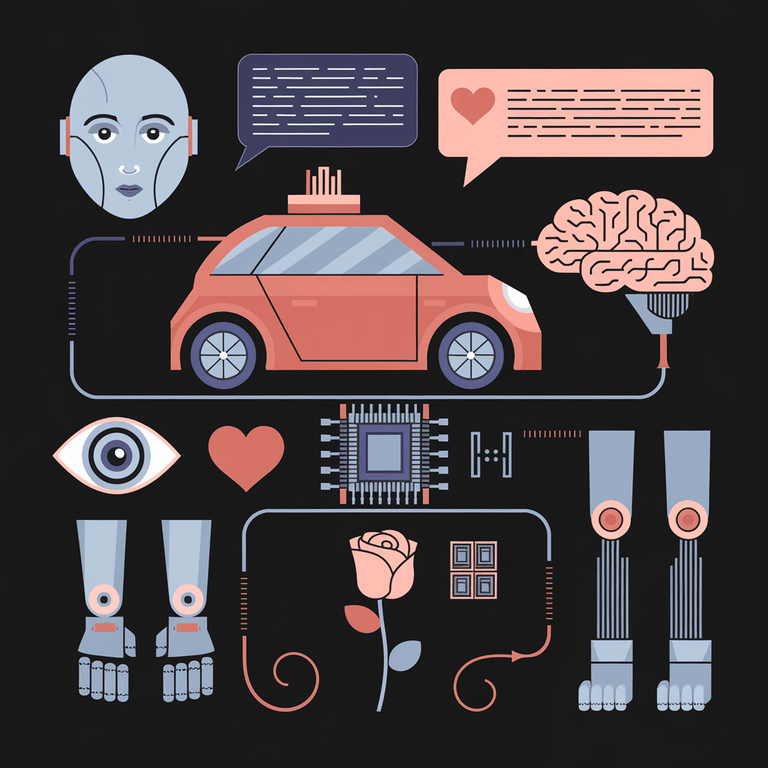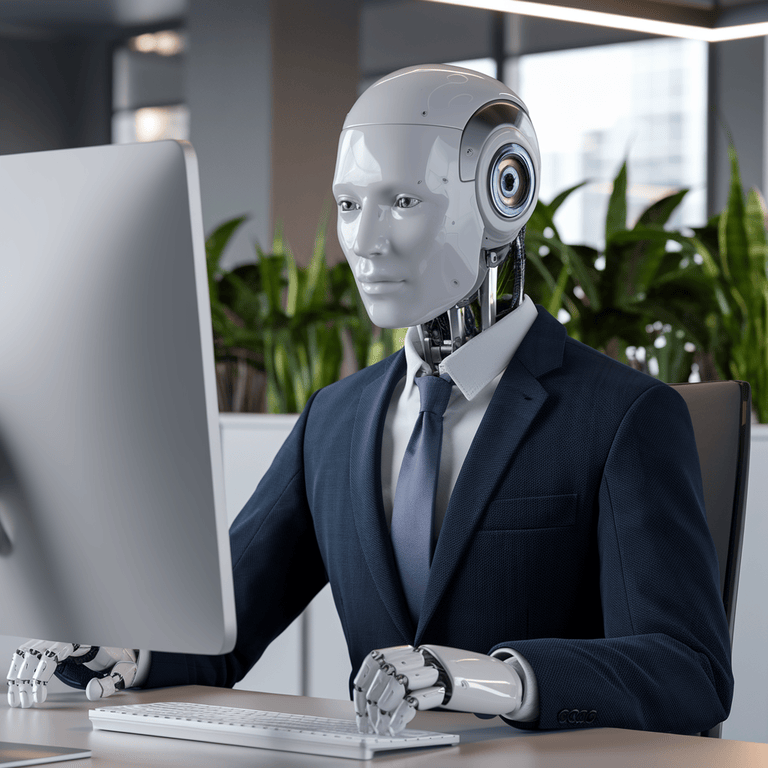AI is making a significant impact on the way we approach web accessibility. As more people use the internet, it’s important that websites are designed to be inclusive, allowing everyone, regardless of ability, to access and interact with content.
With AI technologies, web accessibility is being optimized, making it easier for developers to ensure their sites meet accessibility standards. AI tools can assist in real-time adjustments, audits, and improving user experiences for people with disabilities.
The focus on AI for accessibility is not only about improving the usability of websites for people with disabilities; it’s also about creating a more inclusive online environment for all users.

AI Technologies Enhancing Accessibility
AI is revolutionizing how we make websites more accessible to everyone, including individuals with disabilities. Several AI technologies are driving this change.
Machine Learning and its Role in Predicting User Needs
Machine learning helps AI systems learn from data to predict and respond to user needs. For accessibility, machine learning can:
- Recognize patterns in user behavior, predicting what tools or adjustments they may need.
- Automatically adjust the content or layout to better suit a user’s preferences, such as simplifying text for readability or offering alternative formats.
This means that web pages can adapt to the unique needs of each individual user, ensuring an optimized experience.
Natural Language Processing for Voice and Text Interaction
Natural Language Processing (NLP) is a branch of AI that helps machines understand and interpret human language. It’s crucial for web accessibility in the following ways:
- Voice commands: Users with physical disabilities can navigate websites using their voice, thanks to AI-powered speech recognition.
- Text-to-speech: Text can be read aloud to visually impaired users, helping them navigate content seamlessly.
- Voice responses: Websites can interact with users through AI-driven conversations, making it easier to access information.
NLP can bridge the gap between users and content by converting speech to text or vice versa, making the internet accessible to a broader audience.
Computer Vision for Visual Impairment Support
Computer vision is an AI technology that allows machines to interpret and understand visual information. For visually impaired users, computer vision can:
- Automatically describe images and graphics on web pages.
- Help with navigation by identifying obstacles or highlighting important areas of a page.
AI-powered computer vision tools can translate visual elements into usable information, ensuring that visually impaired users can engage with web content.
AI and Website Accessibility Improvements
AI tools are actively improving the accessibility of websites. Through automated audits, real-time adjustments, and enhanced usability features, AI is playing a major role in making websites more accessible.
Automated Accessibility Audits with AI
AI-powered tools can automatically scan websites to identify accessibility issues. These audits check for compliance with accessibility guidelines, such as:
- Missing alt text for images
- Inadequate contrast between text and background
- Issues with navigation for keyboard users
Instead of relying on manual audits, which are time-consuming and can miss certain issues, AI can quickly and efficiently flag potential problems, ensuring that accessibility standards are met.
Real-Time Adjustments for Better Usability
AI enables websites to make real-time adjustments to improve the user experience. For example:
- Adjusting font sizes for users with visual impairments.
- Changing the layout to accommodate users with cognitive disabilities.
- Offering alternative navigation options, like voice control or gesture-based interactions.
These adjustments make websites more adaptable and user-friendly, ensuring that they meet the needs of all users without manual intervention.
Integration of AI in Screen Readers and Adaptive Technologies
AI can enhance the functionality of assistive technologies like screen readers. By integrating AI:
- Screen readers can better understand and vocalize complex web content, such as tables or forms.
- Adaptive technologies can offer personalized experiences, tailoring content to the user’s specific needs.
These integrations ensure that people with visual or cognitive impairments can navigate and interact with websites more effectively.
Benefits of AI for Accessibility
AI has the potential to make a huge difference in web accessibility, offering a range of benefits that not only improve accessibility for people with disabilities but enhance the overall user experience for everyone.
Expanding Reach to Diverse Users
By integrating AI into websites, businesses can ensure that their online presence is more accessible to a wider audience. AI helps websites:
- Reach people with disabilities, such as those with visual, auditory, or cognitive impairments.
- Adapt to various user preferences and needs in real-time, creating a more personalized experience.
This inclusivity opens the door to a broader range of users, which can ultimately help businesses grow and create a more diverse online community.
Reducing Manual Testing Efforts
Traditionally, accessibility audits and testing were done manually, which can be a time-consuming and error-prone process. AI simplifies this by automating many tasks:
- Automatically identifying accessibility issues during website creation.
- Suggesting immediate fixes, reducing the need for long manual checks.
This means developers can focus more on creating content and features rather than spending hours on testing, making the process more efficient.
Enhancing User Experience for All
While AI benefits people with disabilities, it also enhances the experience for all users. AI-powered features can:
- Make websites more intuitive by automatically adjusting layouts and design based on user preferences.
- Offer real-time language translation, making content accessible to non-native speakers.
- Improve website performance by detecting and resolving issues before they impact users.
This makes the web more user-friendly, regardless of individual needs, ensuring that users have a smoother, more engaging experience.

Challenges of AI in Accessibility
While AI is a powerful tool for improving web accessibility, it’s not without its challenges. There are several concerns that need to be addressed for AI to fully realize its potential.
Bias and Limitations in AI Models
AI models are trained on large datasets, and if these datasets are biased or incomplete, the AI can produce inaccurate or unfair results. In terms of accessibility:
- AI may not always recognize the needs of users from diverse backgrounds.
- There may be challenges in addressing specific accessibility requirements for certain disabilities.
It’s important that AI tools are trained on diverse datasets to minimize biases and ensure that all users are treated fairly.
Privacy Concerns and Ethical Implications
AI technologies often require large amounts of user data to function effectively. This can raise concerns about user privacy and data security:
- Some AI-powered accessibility tools may collect sensitive user data, such as voice recordings or behavior patterns.
- Ensuring that user data is handled ethically and securely is crucial.
It’s important for businesses to implement transparent privacy policies and data protection measures to reassure users that their information is safe.
The Need for Human Oversight in AI-Driven Solutions
Although AI can greatly improve web accessibility, it still requires human oversight to ensure that solutions are effective. AI can help identify issues, but human judgment is needed to:
- Review and validate the suggestions made by AI tools.
- Address complex accessibility needs that AI may not fully understand.
Human expertise in accessibility is still essential for ensuring that the end result truly meets the needs of all users.
Future of AI in Accessibility
AI’s role in web accessibility is only beginning to take shape, and the future holds exciting possibilities. As technology continues to evolve, so will the capabilities of AI tools designed to enhance accessibility. Here’s a look at some key trends and potential advancements.
Trends Shaping AI-Driven Accessibility Tools
Several trends are influencing the development of AI tools for accessibility. These trends promise to make the web more inclusive and user-friendly in the future.
- Increased Automation: As AI models improve, we’ll see more automation in accessibility tools. Websites will be able to detect and fix accessibility issues in real-time, making it easier for businesses to maintain accessible websites.
- Personalization: AI will continue to refine its ability to personalize user experiences. For example, websites will automatically adjust their design, font sizes, and even content structure based on individual user preferences or needs.
- Collaboration Across Fields: The future of AI in accessibility will likely involve greater collaboration between tech developers, accessibility experts, and disability advocacy groups. Working together can lead to better solutions that meet the diverse needs of users.
These trends will help businesses and developers create websites that are not only more accessible but also more adaptable to the evolving needs of users.
Potential Advancements and New Applications
In the coming years, we can expect to see AI evolve in new and innovative ways. Some of the most exciting possibilities include:
- Better Voice Interaction: Voice recognition and AI-driven conversations will become more advanced, allowing for smoother, more accurate communication between users and websites.
- Augmented Reality (AR) and Virtual Reality (VR) Accessibility: As AR and VR technologies grow, AI will play a key role in making these immersive experiences accessible to users with disabilities. AI could help convert visual elements in AR/VR into other sensory forms, such as sound or touch, to ensure accessibility.
- More Inclusive Data Sets: AI will be trained on even more diverse datasets, helping to reduce biases and improve the recognition of various accessibility needs. This will ensure that AI tools serve a wider range of people.
These advancements will continue to push the boundaries of web accessibility, making digital experiences more inclusive and enjoyable for everyone.
Collaboration Between AI Experts and Accessibility Advocates
For AI to truly reach its full potential in web accessibility, ongoing collaboration will be essential. AI experts and accessibility advocates can work together to:
- Ensure that AI solutions are effective and truly address the needs of users with disabilities.
- Help define accessibility standards for AI technologies to follow, making sure that everyone benefits from these innovations.
Working together can help shape a future where AI is a powerful tool for inclusivity and digital equality.
Breaking It All Down
AI is already making a significant impact on web accessibility, and its potential is only beginning to be realized. From improving user experiences through real-time adjustments to making websites more inclusive for people with disabilities, AI is helping to create a more accessible digital world.
As AI technologies continue to advance, they will offer even more powerful tools to enhance accessibility, making the internet a better place for everyone.
It’s crucial for businesses, developers, and accessibility advocates to continue working together to ensure that AI’s capabilities are harnessed in a way that is inclusive, fair, and beneficial to all users.
The future of web accessibility looks brighter than ever, with AI leading the way toward a more inclusive digital experience for everyone.
Frequently Asked Questions
What steps can developers take to integrate AI accessibility tools into their existing workflows?
Developers can start by evaluating current accessibility challenges and identifying tools that complement their coding environments. Integrating plugins, APIs, or standalone applications can help automate audits and adjustments. Testing in stages and gathering user feedback ensures smooth integration.
Which industries stand to benefit the most from AI-driven accessibility solutions?
While every industry can benefit from enhanced accessibility, sectors such as e-commerce, education, healthcare, and government services often see immediate improvements. These industries typically have a diverse user base and high accessibility demands, making AI solutions especially valuable.
How can organizations ensure ethical and secure use of AI in accessibility?
Organizations should implement strict data privacy policies and regular audits. It is essential to choose AI tools that prioritize user security and have transparent data handling practices. Collaborating with accessibility advocates and experts helps maintain ethical standards.
What factors should be considered when choosing an AI accessibility tool for a website?
Consider the tool’s compatibility with existing systems, ease of use, cost, and ability to scale. It’s important to review case studies, user testimonials, and product support services. Testing a trial version can also help determine if it meets your specific needs.
How do AI-powered accessibility tools influence a website’s search engine optimization (SEO)?
Accessible websites often perform better in search rankings because search engines favor clear, structured, and user-friendly content. AI tools that improve accessibility by enhancing metadata, alt text, and content structure can indirectly boost SEO.
Are there training resources available for developers interested in AI for accessibility?
Yes, many organizations offer webinars, online courses, and workshops dedicated to AI and accessibility. Additionally, tech communities and industry conferences provide valuable insights and hands-on training experiences.
How do AI accessibility tools stay updated with evolving accessibility standards?
Reputable AI tools are continuously updated by developers who monitor changes in global accessibility guidelines. Regular software updates and community feedback ensure that these tools remain compliant with the latest standards.
Offsite Resources
WebAIM – https://webaim.org
Offers guidance and tools for web accessibility, including training and resources for improving AI accessibility features.W3C Web Accessibility Initiative (WAI) – https://www.w3.org/WAI
Provides comprehensive resources on web accessibility, including standards and techniques for integrating AI tools.The A11Y Project – https://www.a11yproject.com
A community-driven effort to make web accessibility easier and more accessible, including resources for AI-driven solutions.Google Accessibility – https://accessibility.google
Offers AI-powered tools and solutions to improve accessibility across platforms and services.Microsoft Accessibility – https://www.microsoft.com/en-us/accessibility
Microsoft provides a variety of resources, including AI tools, to enhance digital accessibility for all users.The Center for Digital Accessibility – https://www.digitalaccessibilitycenter.org
Focuses on creating accessible digital experiences, including insights on AI and its role in accessibility.AI for Good – https://aiforgood.itu.int
A global initiative by the UN and AI experts to address accessibility and other societal challenges through AI innovations.

What's Next?
A quick reminder for small business owners: The SEO insights on this page come from our co-founder, Matt LaClear. With over 13,277 SEO campaigns under his belt since 2009, Matt offers extensive experience and proven strategies to boost your online presence.
Don’t miss out on his exclusive offer – a free custom SEO strategy call. It’s the perfect opportunity to receive personalized advice and actionable steps to enhance your SEO and grow your business. Get in touch today and let Matt’s expertise guide your success.

